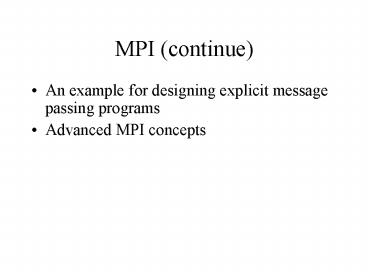MPI (continue) - PowerPoint PPT Presentation
Title:
MPI (continue)
Description:
Title: Message Passing Programming with MPI Author: Xin Yuan Last modified by: Surfing Created Date: 11/23/2006 12:38:31 PM Document presentation format – PowerPoint PPT presentation
Number of Views:91
Avg rating:3.0/5.0
Title: MPI (continue)
1
MPI (continue)
- An example for designing explicit message passing
programs - Advanced MPI concepts
2
An design example (SOR)
- What is the task of a programmer of message
passing programs? - How to write a shared memory parallel program?
- Decide how to decompose the computation into
parallel parts. - Create (and destroy) processes to support that
decomposition. - Add synchronization to make sure dependences are
covered. - Does it work for MPI programs?
3
SOR example
4
SOR shared memory program
grid
temp
1
1
2
2
3
3
4
4
proc1
proc2
proc3
procN
5
MPI program complication memory is distributed
grid
grid
Can we still use The same code For
sequential Program?
2
3
temp
temp
2
3
proc2
proc3
6
Exact same code does not work need additional
boundary elements
grid
grid
2
3
temp
temp
2
3
proc2
proc3
7
Boundary elements result in communications
grid
grid
proc2
proc3
8
Assume now we have boundaries
- Can we use the same code?
- for( ifrom iltto i )
- for( j0 jltn j )
- tempij 0.25( gridi-1j
gridi1j - gridij-1 gridij1)
- Only if we declare a giant array (for the whole
mesh on each process). - If not, we will need to translate the indices.
9
Index translation
- for( i0 iltn/p i)
- for( j0 jltn j )
- tempij 0.25( gridi-1j
gridi1j - gridij-1 gridij1)
- All variables are local to each process, need the
logical mapping!
10
Task for a message passing programmer
- Divide up program in parallel parts.
- Create and destroy processes to do above.
- Partition and distribute the data.
- Communicate data at the right time.
- Perform index translation.
- Still need to do synchronization?
- Sometimes, but many times goes hand in hand with
data communication.
11
More on MPI
- Nonblocking point-to-point routines
- Deadlock
- Collective communication
12
Non-blocking send/recv
- Most hardware has a communication co-processor
communication can happen at the same time with
computation.
Proc 0 proc
1 MPI_Send_start MPI_Recv_start Comp
Comp . MPI_Send_wait
MPI_Recv_wait No comm/comp overlaps
Proc 0 proc 1 MPI_Send
MPI_Recv Comp Comp . No comm/comp
overlaps
13
Non-blocking send/recv routines
- Non-blocking primitives provide the basic
mechanisms for overlapping communication with
computation. - Non-blocking operations return (immediately)
request handles that can be tested and waited
on. - MPI_Isend(start, count, datatype, dest,
tag, comm, request) - MPI_Irecv(start, count, datatype, dest,
tag, comm, request) - MPI_Wait(request, status)
14
- One can also test without waiting
- MPI_Test(request, flag, status)
- MPI allows multiple outstanding non-blocking
operations. - MPI_Waitall(count, array_of_requests,
array_of_statuses) - MPI_Waitany(count, array_of_requests, index,
status)
15
Sources of Deadlocks
- Send a large message from process 0 to process 1
- If there is insufficient storage at the
destination, the send must wait for memory space - What happens with this code?
- This is called unsafe because it depends on the
availability of system buffers
16
Some Solutions to the unsafe Problem
- Order the operations more carefully
Supply receive buffer at same time as send
17
More Solutions to the unsafe Problem
- Supply own space as buffer for send (buffer mode
send)
Use non-blocking operations
18
MPI Collective Communication
- Send/recv routines are also called point-to-point
routines (two parties). Some operations require
more than two parties, e.g broadcast, reduce.
Such operations are called collective operations,
or collective communication operations. - Non-blocking collective operations in MPI-3 only
- Three classes of collective operations
- Synchronization
- data movement
- collective computation
19
Synchronization
- MPI_Barrier( comm )
- Blocks until all processes in the group of the
communicator comm call it.
20
Collective Data Movement
Broadcast
Scatter
B
C
D
Gather
21
Collective Computation
22
MPI Collective Routines
- Many Routines Allgather, Allgatherv, Allreduce,
Alltoall, Alltoallv, Bcast, Gather, Gatherv,
Reduce, Reduce_scatter, Scan, Scatter, Scatterv - All versions deliver results to all participating
processes. - V versions allow the hunks to have different
sizes. - Allreduce, Reduce, Reduce_scatter, and Scan take
both built-in and user-defined combiner functions.
23
MPI discussion
- Ease of use
- Programmer takes care of the logical
distribution of the global data structure - Programmer takes care of synchronizations and
explicit communications - None of these are easy.
- MPI is hard to use!!
24
MPI discussion
- Expressiveness
- Data parallelism
- Task parallelism
- There is always a way to do it if one does not
care about how hard it is to write the program.
25
MPI discussion
- Exposing architecture features
- Force one to consider locality, this often leads
to more efficient program. - MPI standard does have some items to expose the
architecture feature (e.g. topology). - Performance is a strength in MPI programming.
- Would be nice to have both world of OpenMP and
MPI.































